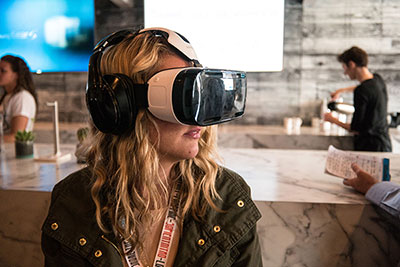
The learning potential of virtual reality in classrooms generated a lot of enthusiasm during ISTE 2016 in Denver. From Google’s $15 Cardboard viewer that utilizes a smartphone to the Samsung VR headsets, teachers were anxious to learn as much as they could about using virtual reality in their classrooms, and education marketers were assessing the depth of interest in virtual reality while fine-tuning their plans for the 2016-17 school year.

Of note for educational marketers is new Samsung research, which reveals:
- 2% of teachers are using virtual reality
- 60% are interested in making it a part of the learning experience
- 83% say that virtual reality may improve learning outcomes by providing:
- Better understanding of concepts – 77%
- Greater collaboration – 71%
- Motivation in the classroom – 84%
Google Expeditions is among the best-known providers of virtual field trips, which have arguably the easiest applicability to classroom instruction. Using smartphones tucked into a cardboard viewer that focuses the viewer’s field of vision, an app displays video that takes students to more than 100 locations for immersive experiences.
Expeditions are collections of linked VR content and support materials that can be incorporated into any curriculum. According to Google, these virtual field trips include 360° panoramic and 3D images – annotated with points of interest. Google is working with content partners, such as PBS, Houghton Mifflin, the Planetary Society and the American Museum of Natural History, to create custom educational content.
Nearpod has released 28 virtual reality lessons that model how to incorporate virtual field trips into curriculum. Using Google Cardboard viewers, teachers can send classes on 25 virtual field trips that offer students a first-person tour of Egyptian pyramids, caves on Easter Island, or a swim through the Great Barrier Reef.
While Oculus Rift and other head-mounted displays are now available to schools, they are priced in the $500 to $1,000 range and are intended for the high-end gamer. The Samsung VR headset at $99 and Google Cardboard at $15 are more affordable options for schools.
In his ISTE wrap-up post, edtech leader Richard Byrne shared that three recent research studies came to the same conclusion about the potential positive benefits of using VR in the classroom: “They first found an improvement in students’ comprehension of geometrical concepts. The second found an improvement in students’ understanding of geometrical concepts and relationships, but only with prior knowledge. And the third study found an improvement in students’ understanding of anatomy.”
While initial student engagement is a given because of the “wow” factor, Byrne cautions educators to not depend on that alone. He believes that the real power of VR is that kids are going to be in control of their learning experiences. As a new medium for content delivery, immersive virtual experiences provide education companies an opportunity to differentiate and personalize learning in a new way. Since it is still early days for integrating virtual reality into the curriculum, first mover companies can establish thought leadership by sharing best practices with their target audiences.
This post is the first in a two-part series on the state of gaming in K-12 schools. Next we’ll take a look at the research underpinnings for game-based learning strategies in the classroom.
I’ll be presenting a session called “These Bananas Aren’t Going to Sell Themselves” next week at the Serious Play Conference at the University of North Carolina at Chapel Hill. The focus is on creating a game plan to put educational marketers on the path to success. If you can’t make the conference, email me at charlene@cblohm.com to get the deck or just chat more about options that might be right for you.


